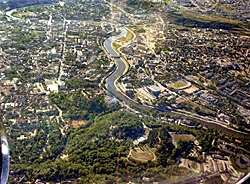Vilnius Picture Gallery - Lietuvos dailes muziejos
|
| Sure, the Dutch painters, like van Gogh and those were great, and yes, the French 19:th
century painters could paint OK, but the Lithuanian ones from the same time were just as good. Convince yourself
by visiting the Vilnius Picture Gallery in the Old Town. The house was made an art museum in 1994. |
|
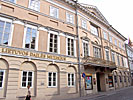
|
The museum is housed in a former palace built in the 17:th century by the noble Lithuanian Chodkeviciai family. |
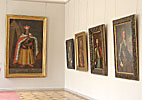
|
The gallery starts with room number one, displaying fictive pictures of all early kings. |
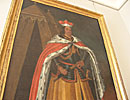
|
Painting number one shows Grand Duke Vytautas. No one knows what he looked like. |
|
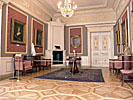
|
Ceilings and walls are completely intact, with stucco and gold leaf. I could live there. |

|
Perhaps the museum’s most famous painting of all, “Harvest Girl” (Pjoveja) av Kanutas Ruseckas. It is used
everywhere, on chocolate gift boxes and such. |
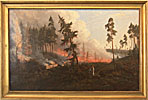
|
“Forest Fire” (Misko gaisras) av Vincas Dmachauskas is another famous painting. It reminds me al lot of the Finnish
“Burn-beating Fins” (Svedjefinnar) I saw in Helsinki |
|
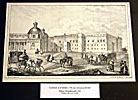
|
If you are a true Vilnius fan and know the city and surroundings,
there’s a lot of goodies to be found here. Especially in the Vilnius exhibition, such as Basanavicius’ paintings
and copperplates of environments and buildings from the 18:th century. With a little imagination you’ll recognise
modern Vilnius and after some time you can navigate around on the century old images.
All names and descriptions of the works are translated into faltering English. It is somewhat miserable that a
government-run museum doesn’t use proper translations. “The Lower Castle” has become “The Law Castle”. |
Maybe, perhaps photography was just a little prohibited, but I thought it was better that
I show the works to the world than they remain unseen. People weren’t exactly stampeding to get into the museum.
Unfortunately they had only two paintings by Cirulionis, the great composer, mystic and Science Fiction painter.
If you want to se more of him, you’ll have to got to the Ciurlionis Museum in Kaunas. Do it! Ciurlionis
is unique, to say the least. |
|
Vilnius' Opera
|
|

|
The Vilnius Opera is a magnificent building with extravagant interiors. It was built in the Soviet days, but works
well and has good acoustics anyway. In those days, when the Bolshoi Theatre was booked, the great operas and plays
were premiered in Vilnius instead. |

|
In the Opera House bar. This is how a bar should look like. All sorts of liquors, coffee and goodies for the pleasure-seeking
opera-goer, and not like in Stockholm, buns in plastic bags, with astronomic prices. |
The Lithuanian National Museum - Lietuvos nacionalinis muziejos
|
The National Museum is situated in a park beside the cathedral, below the castle hill with
Gediminas Tower. The house is slightly crooked in the middle because it is built along the old city wall (gone
a long time ago). It was originally built as an arsenal (and is therefore on 1 Arsenal Street), but has been rebuilt
many times. The last time they did something to it was in the 17:th century.
The museum depicts Lithuanian history from the sticks and stones age, through crooked-rusty-swords age, farming
society with harvest and flax preparation, traditional costume, kings, the Radvilas family’s contributions to museums,
and a giant painting of the nobleman and culture magnate Tiskevicius. The history of Vilnius University and staff
is also illustrated, with images from the end of the 19:th century when the university was closed and used as a
museum.
Don’t expect flashy tableaux or fantastic dioramas. Instead it is more of the grey everyday history from a country
which had to fight and bleed to be allowed to show it.
Paintings, on the other hand, you’ll find at Vilnius
Picture Gallery in the Old Town. History about weapons and fighting is on the War
Museum in the Arsenal. |
|
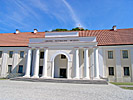
|
The museum is in the absolute city centre, beside the cathedral. In front of the gate is the new statue of king
Mindaugas. |
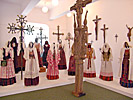
|
Lithuania has a very rich costume tradition. The ornate wooden crosses are district specific, and are found all
over the country. |
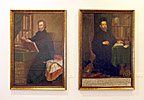
|
The gentleman to the left is Rector Primarius Skarga, who was ordered to change his religious school in Vilnius
to a university. He became its first headmaster in 1580 and had the first schoolyard
named after him. Skargas’ yard. |
|
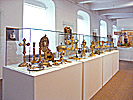
|
In the middle is a collection of religious art, objects saved from the Communists from various churches around
the country. |
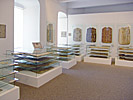
|
All this is things you really should see if you are interested in Lithuanian history. |

|
These giant Vatican keys are salvaged from the church in Trakai village. |
|
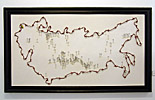
|
One room contains an unpleasant collection of object from the Soviet time, art and objects collected from or made
by the innumerable Lithuanians deported, tortured and eliminated in the Soviet concentration camps. This not very
nice picture shows the Soviet Union border made in barbed wire, with crosses in all the places where captive Lithuanians
died or were executed. Lithuania is inserted, properly scaled, in the upper left corner. Then there are old diaries,
suitcases, weapons and terrible stories about life in Siberia, and the horrible life and death of the Forest Brothers
in Lithuania’s forests. |
Martynas Mazvydas National Library of
Lithuania - Lietuvos nacionaline Martyno Mazvydo biblioteka
|
| In 1547 Martynas Mazvydas had the first book in Lithuanian language printed, the Catechism
(n.b. only 160 years after the country was Christened, in 1387) and so laid the foundation of all Lithuanian library
activity. Thus he has been honoured by giving his name to the Lithuanian National Library. The interior is more
than grand, it’s super-grand. But you won’t get in there. Only the library card holders, the “readers” will get
in through the electronic gates. As a tourist you might want to expose yourself to a lengthy registration procedure,
or sweet-talk them into giving you a temporary pass. This probably helps decreasing theft, but it doesn’t feel
like a public library. |
|
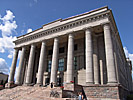
|
The National Library is situated beside the Parliament on Independence Square. |
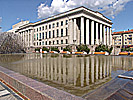
|
Between the library and the Parliament is a pool with a controlled waterfall and a fountain at the far end. |
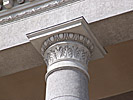
|
The house was built long before Communism. It looks nice. The Commies would never make adornments like this. |
|
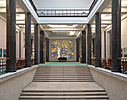
|
This is the most common view of the library in the media, the main staircase to the first floor. At the far wall
is a giant glass mosaic. |
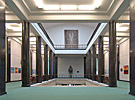
|
With your back against the glass mosaic the staircase looks like this. Mazvydas stands opposite and checks you
out. |
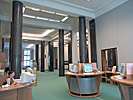
|
Just like in Swedish libraries, there are computerised, microfilm and cardboard catalogues. All registration on
cardboard cards ended in 1997. |
|
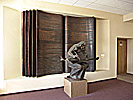
|
Here Mazvydas himself sits, writing in a specialist literature room. Behind him is a replica of his first Lithuanian
book, the Catechism. |
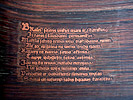
|
The first text page in the first book, beginning: “Brothers and sisters, take me and read me.” Sculptor K. Kisielis. |
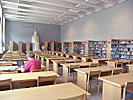
|
A specialist literature room. The large, enormous book collections are absent. This is an ordering library. The
books are kept all over the town, but you could get any book within an hour. |
|
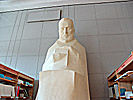
|
Unknown giant. Any comments welcome. |
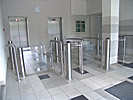
|
Electronic gates and guards probably lets the library keep its books. |
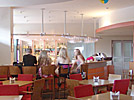
|
A bar at the library? This would be unthinkable in sober Sweden, but on the continent it’s okay. They would rather
enjoy than sit around and be bored. |
About Martynas Mazvydas
circa 1520 - 1563
|
|
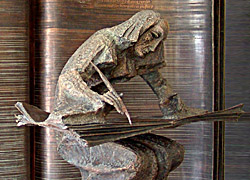
|
Martynas Mazvydas was a priest, poet, author, public educator and a hip guy in general. He printed the first book
in Lithuanian, the beginning of all Lithuanian literature and poetry. The book was called “The simple words of
Catechism” but was much more than a religious textbook. It also had an ABC book and a number of songs. The idea
was to teach the Lithuanian people to read their own language and spread the culture, apart from fearing God. He
tried to eliminate the remains of paganism and push for Protestantism.
The book starts with a dedication to the Grand Duchy of Lithuania, two prefaces in Latin and Lithuanian, and then
the famous Lithuanian preface. Knigieles pacias byla Letuvinikump ir Zemaiciump, that is “The Book speaks
to Lithuanians and Zemaitijans”. It is the book, or perhaps the art of reading, that proclaims to its brothers
and sisters that the world waits for the one who starts reading here. |
|

|
The cover text (left) reads “The simple words of the Catechism, a reading and writing manual, songs for Christians
and for young children, recently prepared i Köningsberg, the eighth day in the moth of January in the Lord’s
year 1547. Glory be unto God alone.” |
|

|
KNIGIELES
Pacias byla Letuvinikump ir Zemaiciump
BRalei, seseris, imkiet mani ir skaitikiet
Jr tatai skaitidami permanikiet.
Maksla šito tevai iusu trakzdava tureti,
Ale to negaleia ne venu budu gauti.
Regiety to nareia sava akimis,
Taip yr išgirsti sava ausimis.
Jau nu, ka tevai nakada neregieia,
Nu šitai viss iusump ateia.
Veizdekiet ir dabakietese, zmanes vysas,
Šitai eit iusump zadis dagaus karalistas.
Malanei ir su dziauksmu ta zadi prijimkiet,
A iusu ukiusu šeimina makikiet.
Sunus, dukteris iusu tur tatai makiety,
Visa šyrdy tur ta deva zady milety.
Jei, bralei, seseris, tus zadzius nepapeiksit,
Deva teva ir sunu sau milu padarisit.
Jr pašlavinti pa akimis deva busit.
Visosu daiktosu palaimi turesit.
Šitu makslu deva tikrai pazysyt
Jr dagaus karalistasp prisiartysyt.
|
The LITTLE BOOK [Itself] Speaks to Lithuanians and Zemaitijans
Brothers, sisters, take me and read me,
And reading, consider this:
Your fathers fervently desired to have this doctrine
But were not able to obtain it in any way.
They wanted to see it with their eyes,
And also to hear it with their ears.
Now what your fathers never saw,
Now all this has come to you.
All men, look and pay attention,
Look the word of the kingdom of heaven is coming to you.
Receive this word graciously and with joy
And teach the family in your homes.
Your sons and daughters should know this
And love this word of God with all their heart.
If your brothers and sisters will not scorn these words,
You will make God the Father and the Son dear to you.
And you will be blessed under the eyes of God.
You will have blessing in all things.
With this doctrine you will truly know God
And will come near to the kingdom of heaven.
|
|
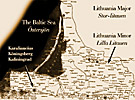
|
The same text is reproduced on the extravagant door to the University Library.
The reason that the book was published in Köningsberg (Karaliauciai = King’s City), modern day Kaliningrad,
is that it was the capital of ancient Little Lithuania, stretching from Kalaipeda in the north to Karaliauciai
in the south. He addresses both Zemaitijans and Lithuanians, because Little Lithuania was his country, partly overlapped
by Zemaitija, an independent country at the time. Greater Lithuania, on the other hand, once stretched all the
way to the Black Sea and nearly reached Moscow.
The text is in a Zemaitijan dialect, the language spoken near Kalipeda. The text misses many diacritical marks,
so it is not possible to pinpoint it to any one of the dialects spoken around 1547. Scientists differ about where
Mazvydas actually lived although his official dwelling is in present day Kaliningrad. Tourists still visit it.
Despite there being no distinction between “i” and “j”, and the pronunciation of some characters have changed (“y”,
long i-sound is now “i” in some modern Lithuanian words etc)... |
and ancient character combinations of ch-sounds has been replaced by accented characters (sch > š, sz > z)
a modern day Lithuanian has no problems reading the text as the sounds are still the same. The Lithuanian language
is unique in that written and spoken languages are identical. And an “ump” (u with nose) and an “asp” (e with nose)
here and there was something you just had to accept in the medieval days. They are concessions for the cases.
(Swedish, on the other hand, has changed so much since the 16:th century that you have to be a linguist to be able
to understand and old text.)
He was a smart man, Mazvydas. He fixed his own copyright by weaving his name into the first letter of each line
(in Latin):) MARTINUS MAŠVIDIUS and not only in the introduction but at many
other places in the text.
There are statues of Mazvydas all over the country. He has even got a mountain peak in Khirgistan named after him.
The Mazvydas Peak stretches 4560 meters above sea level, and is part of the Terskej Alatau range. It got
its name from Lithuanian climbers, the first ones there, in 1979.
Read more about Zemaitija here. |
|
